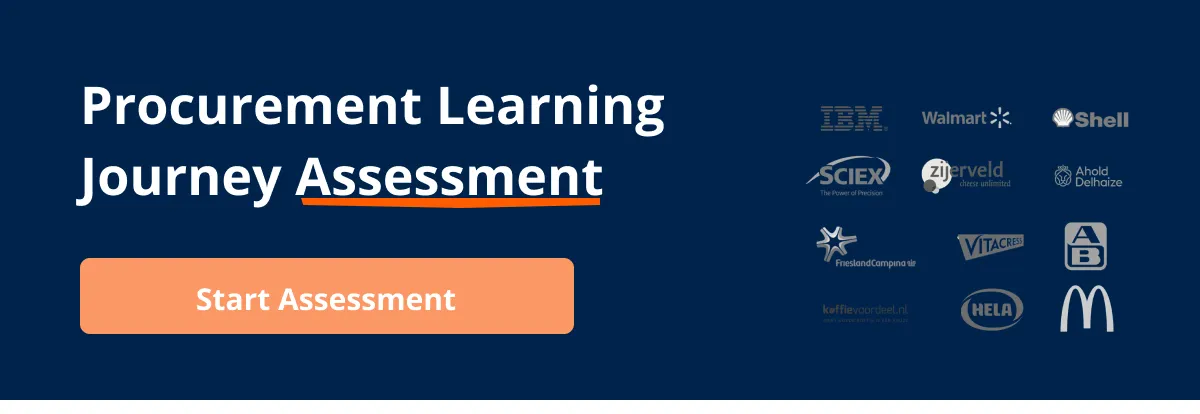Written by Marijn Overvest | Reviewed by Sjoerd Goedhart | Fact Checked by Ruud Emonds | Our editorial policy
Procurement vs Sourcing — 5 Crucial Differences You Should Know
Key takeaways
- Procurement involves purchasing necessary items for your company, while sourcing is the process of finding the suppliers offering the materials you need.
- Procurement guarantees the smooth flow of inputs and supplies whereas sourcing makes the procurement process easier.
- Distinguishing between procurement and sourcing enables procurement managers and professionals to establish distinct objectives for each process.
It’s amazing how words that are constantly being used for a single particular thought can end up confusing so many people.
The words hold true for two peculiar terms. The first term is procurement and the second term is sourcing. Both words are always used to represent one important thought though; to get things for the company.
So for today, we are going to talk about the difference between procurement and sourcing. We’ll each talk about each term, give examples, and at the end of the day, clear up the confusion that has hounded countless procurement managers and numerous companies.
I have created a free-to-download editable procurement process: 7 steps template. It’s a PowerPoint file, together with an Excel file, that can help you streamline your procurement and sourcing process. I even created a video where I’ll explain how you can use this template.
What is Procurement?
Procurement is the full process of sourcing and gathering all the materials needed for your products and services. It is the moment when you are placing purchase orders for numerous printers, computers, and all other machines needed by the company.
To put it simply, procurement is when you buy things that are needed for your company.
For the procurement manager, the process of procurement involves from planning purchases, negotiating market prices, placing the order with each supplier, getting the order confirmation for each purchase, up until following up with the suppliers until all materials are delivered to the office come delivery day.
If a company doesn’t have a decent procurement process, operations within the company will most likely halt. Imagine if your company’s procurement manager failed to buy the computers that are needed for you and your co-workers to work in. It would be disastrous for the company and for you if the company closes.
This is why companies invest billions of dollars in procurement systems to make sure that the company’s procurement process is up to date and working perfectly for the company.
What is Sourcing?
Sourcing, to put it simply, is to find the supplier where the materials you need to procure are being offered or sold.
Because if you can’t find a good supplier for the materials that you need to procure or buy, then to whom are you going to buy it from?
The process of sourcing is an actual stage that is set way before the procurement process. Again, if you can’t find a good retailer for the computers that you need to procure, then you are going to have a big problem.
A good sourcing process will give you a list of reliable, affordable, and quality suppliers who can give you the items that you need for procurement.
What is the Difference Between Procurement and Sourcing?
For this question, we are going to simply divide each fact into five important points. To make things simpler, here’s a chart that we at Procurement Tactics designed:

Why is it Important to Learn The Difference Between Procurement And Sourcing?
Procurement managers often think that procurement is the same as sourcing. Thus, they fail to incorporate the importance of sourcing in a procurement process simply because both terms mean the same thing.
Recognizing sourcing will save you (and your company) time and money. You can create a sourcing process to look for potential suppliers before you start the procurement process.
In cases where automated procurement systems are required, a procurement manager who is unable to tell the difference between procurement and sourcing will not be able to make full use of the automated program.
Learning the difference between procurement and sourcing is basic knowledge among procurement managers.
Recognizing the potential of both sourcing and procurement will give you, the procurement manager, the edge in negotiating with suppliers and vendors. You can take your pick from the best suppliers and you can negotiate for better prices per supply.
Strategic Sourcing: What is it?
Strategic sourcing is growing in popularity in the field of procurement but what really is it? Strategic sourcing is an approach that puts overall value on the relationship with the supplier rather than its provided product or services.
It is a part of supply chain management and puts emphasis on customized solutions and strategic partnerships.
Furthermore, it is a long-term process that needs large investments in advanced technological platforms, tools, and personal skill sets for its successful implementation.
Difference Between Strategic Sourcing and Procurement
You may ask, what is the difference between strategic sourcing and procurement? Well, let us take a look at how it is different from each other for you to understand when and which term to be used when you are in the field.
Procurement, in its definition, is the process of gathering the materials you need for your products and services through suppliers. The procurement department will place its orders with suppliers, receive the materials, and pay for them.
Procurement is an end-to-end process that covers various activities such as planning, negotiating prices, inventory control, and purchase orders.
It starts the supply chain process because once the materials you need are delivered to you, you can now make the products you are going to sell to others.
On the other hand, strategic sourcing happens before purchases and is typically part of the procurement department.
Before any purchases are made and any contracts are signed, you must first find potential suppliers. In strategic sourcing, you will identify suppliers that are an ideal fit for your needs.
In an enterprise, strategic sourcing is one of the components of supply chain management that represents strategic planning, contract negotiation, supplier development, and outsourcing models.
In the service sector, strategic sourcing is often understood as a service solution that is specifically tailored to meet the individual needs of the client.
Service sourcing strategy may include the transfer of business practice to another company, characterized by the transfer of personnel and assets to an outsourcing company. For example, companies like McDonald’s and Microsoft use Vested Outsourcing Agreements.
Benefits of Strategic Sourcing
The following are some of the beneftis of strategic sourcing:
1. Improve cost savings
Strategic sourcing considers the total cost of ownership (TCO) which leads to more long-term cost savings for your business.
These savings have a positive impact on financial profitability which is reduced by commissions, overhead costs, and cost of goods sold among other expenses.
2. Enhance efficiency and operation
Strategic sourcing allows you to pre-qualify suppliers for future projects which can shorten sourcing timelines.
Additionally, as strategic sourcing gives emphasis on the importance of the relationship with your supplier, it can foster collaborative supplier relationships that will provide your company with opportunities to innovate.
By using automation and introducing sourcing standards in your company, it will gain a systematic approach when selecting the best supplier for future projects.
3. Improve compliance
Strategic sourcing enables companies to identify suppliers that have the values and practices. Additionally, it ensures that suppliers meet compliance and regulatory guidelines as it allows companies to verify the background of all their potential suppliers.
4. A stronger relationship with your suppliers
As we told you earlier, strategic sourcing is an approach that puts overall value on the relationship with the supplier rather than its provided product or services.
Thus, working closely with your suppliers should enable you to develop meaningful relationships with each other. Stronger relationships with suppliers can pave the way for more favorable contractual terms.
Procurement Expert’s Advice on Procurement and Sourcing
For this article, we asked an experienced procurement expert to share her insights to help answer common questions about the procurement and sourcing process.
Nesrin Chabbah
Senior Lead Buyer
LinkedIn Profile: linkedin.com/in/nesrin-chabbeh
1. What do most people get wrong about procurement and sourcing?
“Procurement involves the whole process of buying materials, while sourcing is about finding the right supplier. Procurement is comprehensive, managing the flow of supplies, while sourcing focuses on supplier identification, aiding the procurement process. Distinguishing these is essential for effective resource acquisition in a company.”
2. What should people know about procurement and sourcing if they are planning to start working on this?
“Procurement is buying goods or services. Sourcing is finding suppliers.”
3. From your experience, what is the most important thing you learned about procurement and sourcing?
“Having experience in both procurement and sourcing, clarity within some organizations was sometimes lacking. In sourcing, we went as far as creating technical catalogs for products. From this experience, a crucial lesson emerged: strategic sourcing significantly enhances procurement outcomes. Supplier relationships are vital. Efficient procurement systems are crucial for smooth operations. Customized strategies drive cost-efficiency and productive collaboration with suppliers. Integration proves pivotal.”
4. Could you please provide some tips on how to be effective with procurement and sourcing?
“A crucial tip for enhancing effectiveness in procurement and sourcing is to establish clear and well-defined processes, enabling individuals to perform their tasks more efficiently.”
5. Can you give us an example of the difference between procurement and sourcing?
“Procurement includes negotiating, but Sourcing involves researching and identifying potential suppliers.”
Conclusion
Understanding the difference between procurement and sourcing is crucial for a comprehensive understanding of the end-to-end supply chain process.
Procurement involves the entire process of acquiring materials and supplies needed for a company, starting from planning purchases to negotiating prices, placing orders, and ensuring smooth material flow. It is a holistic approach that ensures the operational continuity of a company.
Sourcing, on the other hand, is a specific stage within the procurement process that focuses on finding reliable, affordable, and quality suppliers for the materials needed. An effective sourcing process streamlines procurement by providing a curated list of potential suppliers before the formal procurement activities commence.
Strategic sourcing is an integral aspect that emphasizes the value of relationships with suppliers over the products or services they provide. This approach, a part of supply chain management, involves customized solutions, strategic partnerships, and long-term investments in technology and skills.
Recognizing the difference between procurement and sourcing is essential for procurement managers, as it not only saves time and money but also allows for the optimal utilization of automated procurement systems. In a rapidly evolving business landscape, a nuanced understanding of these concepts provides procurement managers with a competitive edge in negotiations and supplier interactions.
Frequently asked questions
What is the difference between procurement and sourcing?
The difference between procurement and sourcing is that the former is all about buying materials while the latter is about looking for where to buy the materials.
What is procurement?
Procurement is the process of buying materials/products for the company. It can be used for the company’s daily operations or the company’s growth.
What is sourcing?
Sourcing is the procurement process of looking for good sources of products/materials at cheaper costs.
About the author
My name is Marijn Overvest, I’m the founder of Procurement Tactics. I have a deep passion for procurement, and I’ve upskilled over 200 procurement teams from all over the world. When I’m not working, I love running and cycling.


